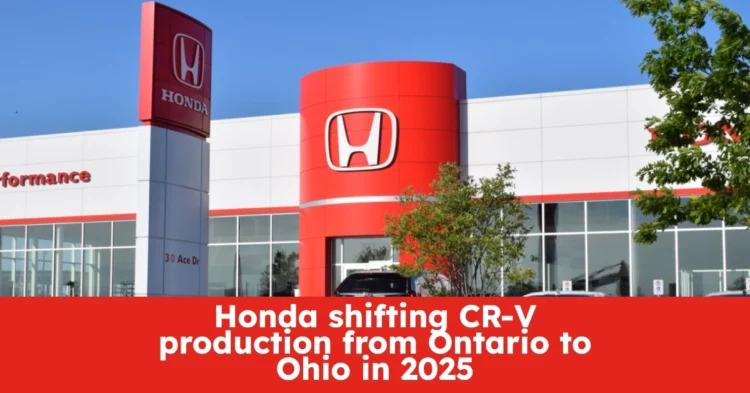In a move tied to trade policies and production strategy, Honda has announced a shift in CR-V production for U.S. markets from its Canadian facility in Alliston, Ontario to its East Liberty Plant (ELP) in Ohio. The decision appears to be a response to lingering tariff concerns originating during the Trump administration. While the news might initially sound alarming for Canada’s auto manufacturing industry, especially for Alliston workers, Honda says there are no immediate plans to reduce production at its Ontario plant.
Table of Contents
Why is Honda Moving Some CR-V Production to the U.S.?
During a recent earnings call, Honda CEO Toshihiro Mibe stated that CR-V models destined for the U.S. will now be manufactured at the East Liberty Plant in Ohio (ELP). This shift aims to mitigate the impact of potential U.S. tariffs on Canadian-made vehicles, ensuring Honda’s competitiveness in its largest North American market.
- Canada made 214,095 CR-Vs in 2024
- Only 55,363 were sold in Canada
- The remaining ~150,000 vehicles were primarily exported to the U.S.
That 150,000-vehicle production gap now poses a serious question for the Alliston facility.
New Rules for Senior Drivers 2025: Licence Renewal Processes Across All Canadian Provinces
What Does This Mean for Canadian Manufacturing?
Honda’s official response has been cautious but reassuring — at least for now. In a statement, the company said:
“We can confirm that our Canadian manufacturing facility in Alliston, Ontario, will operate at full capacity for the foreseeable future and no changes are being considered at this time.”
While this indicates no immediate layoffs or slowdowns, it does leave the door open for future changes depending on global market demands and manufacturing strategy. It’s unclear whether Alliston’s lost U.S.-bound production will be replaced by new models or redistributed to other markets.
What Happens to the Alliston Plant?
Alliston has been the global lead plant for CR-V production since 2012, which gives it significant prestige within Honda’s global network. However, the shift of U.S.-bound CR-V production could mark a change in that status. Whether this will impact the plant’s long-term role within Honda’s production hierarchy remains to be seen.
There are a few potential outcomes:
- Backfilling Production: Honda may introduce another vehicle model to the Alliston line to replace the CR-V units headed to the U.S.
- Export Realignment: The same number of CR-Vs may still be built in Canada but redirected to other global markets.
- Strategic Diversification: Honda could introduce electric or hybrid models as part of its EV roadmap in Canada, especially as it explores new manufacturing goals post-2025.
Honda’s U.S. CR-V Production Stats
- Indiana Plant: 172,706 CR-Vs in 2024
- Ohio (ELP): 109,097 CR-Vs in 2024
- Canada (Alliston): 214,095 CR-Vs in 2024
The Ohio facility is the only U.S. plant confirmed to be picking up additional CR-V volume, likely because of its flexibility and existing CR-V infrastructure.
Impact on Canadian Drivers and Economy
While Canadian consumers are unlikely to notice any immediate difference in the availability or pricing of CR-Vs, this move raises concerns about:
- Auto sector employment in Ontario
- Future investment in Canadian manufacturing
- The shifting balance of North American vehicle production
For drivers and workers alike, this development underscores the importance of international trade policy in shaping what we drive, where our vehicles are made, and the stability of our local economies.
Final Thoughts: Change on the Horizon?
Honda’s move is not a full withdrawal from Canadian production, but it does suggest a strategic pivot in North American manufacturing. If the Alliston plant loses its “lead plant” status, it could affect its role in future Honda planning, particularly around EV and hybrid expansion.
That said, Honda’s comment about maintaining full capacity “for the foreseeable future” is a critical signal of stability — for now.

